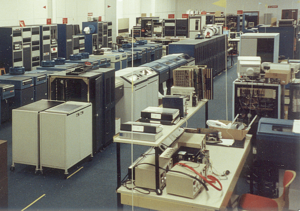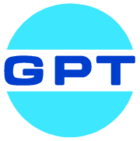GEC Computers facts for kids
GEC Computers Limited was a British company that made computers. It was part of a larger group called the GEC. The company made computers from 1968 until the 1990s. They were best known for their GEC 4000 series minicomputers. These computers were often used to control things in real-time, like in factories or for military uses.
Contents
History of GEC Computers
How the Company Started
GEC Computers began as a company called Elliott Automation. In 1967 and 1968, the British government wanted to reorganize big companies. As a result, Elliott Automation's data processing computers were moved to another company called ICL. Other parts of Elliott Automation went to English Electric. English Electric then joined the GEC group in 1968.
Elliott Automation kept the systems that controlled things in real-time, like the Elliott 900 series computers. They then started designing a new set of computers. Because of the reorganization, Elliott Automation couldn't work on data processing computers for several years.
Developing New Computers
The company planned three new types of computers. They called them Alpha, Beta, and Gamma.
- Alpha became the GEC 2050, a smaller 8-bit computer.
- Beta became the GEC 4080, a 16-bit computer with a special feature called Nucleus.
- Gamma was never fully developed, but some of its ideas were added to the GEC 4080.
The main product for GEC Computers was the GEC 4000 series minicomputers. Many other companies within GEC and Marconi used these computers. They were used for controlling systems in industries and for military purposes. The company kept making new versions of the 4000 series for most of its life.
In its early years, GEC Computers also made the GEC 2050, computer power supplies, and special high-resolution screens for military use. They also continued to support the Elliott 900 series for older customers. Sometimes, the software GEC Computers made for itself was so good that other companies wanted to buy it. This included software for paying salaries, designing circuit boards, and managing projects.
Expanding with OS4000
In the mid-1970s, GEC Computers developed OS4000. This was a more advanced operating system for the GEC 4000 series. OS4000 helped the 4000 series reach more customers, including universities and research groups. GEC Computers worked with these groups on many projects. Some of these projects led to new products that GEC Computers sold. For example, they developed X.25 packet switch systems from working with the NERC.
In the late 1970s, the Post Office Telecommunications developed Prestel. This was a system that let people get information on their TVs using a phone line. Prestel was built using the GEC 4000 series computers. This led to GEC Computers selling similar systems all over the world.
In 1979, the company won the Queen's Award for Technical Achievement. This award was for their work on the 4000 series, especially the Nucleus feature.
Growth and New Partnerships
By 1980, OS4000 was popular in UK universities and research places. It was used as a system where many people could use the computer at the same time. To serve this market, GEC Computers worked with an American company called A. B. Dick in the early 1980s. They developed the GEC Series 63. This computer could run OS6000 (which was based on OS4000) or UNIX System III and later UNIX System V. However, the Series 63 did not sell very well and was stopped in 1987.
GEC Computers had many systems across the UK. This meant they had a large team that could fix computers on-site quickly. This was a very useful service. Many new technology companies struggled to offer this kind of support. So, GEC Computers started fixing computers for other companies too, even some that competed with them.
Throughout the 1980s, GEC Computers grew. They moved from their offices in Borehamwood to three large factories in Dunstable. However, as the business got smaller in the 1990s, they closed these factories.
Because GEC Computers had a strong presence in UK universities and a good field service team, Sun Microsystems chose them. Sun Microsystems wanted GEC Computers to help launch their Sun-2 computers in the UK in the early 1980s. GEC Computers sold these as the GEC Series 42. GEC Computers also made cheaper workstations called the GEC Series 21. These were based on Atari 520ST and 1040ST systems. GEC Computers didn't sell many Sun systems, so Sun opened its own offices in the UK. However, GEC Computers continued to fix Sun Microsystems computers across the UK for many years.
At its busiest time in the early 1980s, GEC Computers had about 1,600 employees. Most of them worked in Borehamwood and Dunstable. They also had small offices in many other countries.
Decline and End
By the 1990s, the market for real-time control systems changed. Newer, cheaper systems based on microprocessors became popular. This meant that sales of the GEC 4000 series dropped. Also, X.25 networks were replaced by the Internet, so sales of X.25 packet switches also went down.
This left only the sales of Videotex systems to other countries. So, the company focused on this product. But the World Wide Web soon replaced Videotex systems. This meant the company's last main market ended.
From the mid-1990s, GEC Computers stopped making new systems. However, they continued to maintain and fix the systems they had already sold. They also continued to offer third-party maintenance services for other companies.
Company Name Changes
The company had many names during its lifetime. However, "GEC Computers" is probably the most well-known name. This is because it was used when the company made its main products in the 1970s and 1980s.
Here are the names the company used:
- Elliott Automation
- Marconi Elliott Computer Systems
- GEC Computers Limited
- GPT Computers Limited
- GPT Data Systems
- GPT Video and Data Systems
After these names, the rest of the company became part of Marconi Communications, and later Telent.
GEC Computers was allowed by GEC not to use the usual GEC logo on its products. This was because the GEC logo looked a bit old-fashioned, even in the early 1970s. The company wanted a newer look for its brand.
Products and Services
GEC Computers made and supported many different products and services:
- Marconi Transistorised Automatic Computer (T.A.C.): Used in nuclear power stations to show data.
- Marconi Myriad and English Electric M2100: They mainly maintained existing versions of these computers.
- Elliott 900 series: Older computers that GEC Computers continued to support.
- GEC 2050: An 8-bit minicomputer.
- GEC 4000 series: Their main line of 16-bit minicomputers. They also developed operating systems for them like COS, DOS, OS4000, and SCP-2.
- GEC Series 21: Cheaper workstations based on Atari ST systems.
- GEC Series 42: Rebranded Sun-2 and Sun-3 computers.
- GEC Series 63: A computer that could run OS6000 or UNIX.
- Early power supplies: They made special power supplies for other companies.
- High-resolution colour screens: Mainly for military use.
- Computing consulting: They offered advice on computing, mostly to other GEC companies.
- Third-party maintenance: They fixed computers for other companies.
- X.25 packet switches: Devices that helped send data across networks.
- Public Videotex and private Viewdata systems: Systems that allowed people to access information on screens, like Prestel.
- Electronic and cable assembly manufacturing: They made electronic parts and cables for other companies.





